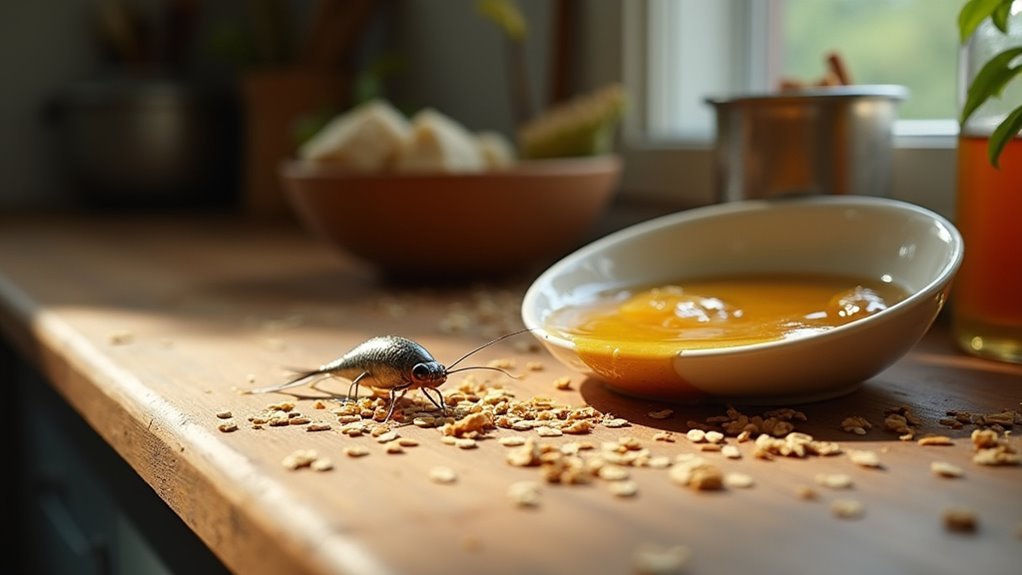You can eliminate silverfish naturally by reducing humidity below 50% with dehumidifiers, sprinkling diatomaceous earth along baseboards, and using cedar oil or essential oils like peppermint as repellents. Seal cracks with caulk, store food in airtight containers, and place cinnamon in cupboards to disrupt their activity. Regular vacuuming eliminates food particles while citrus peels create natural barriers. These methods target silverfish’s moisture needs and food sources to guarantee they won’t return to your home permanently.
Reduce Humidity Levels Throughout Your Home

Since silverfish thrive in humid environments above 75%, you’ll want to maintain humidity levels below 50% throughout your home to effectively deter these pests.
Installing a dehumidifier in damp areas like basements and bathrooms will greatly reduce moisture levels that fuel your silverfish problem.
Strategic dehumidifier placement in moisture-prone areas like basements and bathrooms effectively eliminates the high humidity levels that silverfish need to survive.
You should regularly ventilate closed rooms and attics by opening windows or using fans to promote airflow and decrease humidity.
Don’t forget to fix leaky pipes and guarantee proper drainage around your foundation to prevent moisture accumulation.
Running bathroom fans during and after showers helps expel humid air quickly.
These simple steps to reduce humidity levels will create an environment where silverfish can’t survive.
Use Diatomaceous Earth as a Natural Dehydrator
You’ll find diatomaceous earth to be one of the most effective natural silverfish eliminators because it works by puncturing their exoskeletons and dehydrating them to death.
The key to success lies in applying a thin, dry layer in the right locations where silverfish hide, such as baseboards, cracks, and behind appliances.
This non-toxic powder offers a safe yet lethal solution that won’t harm your family or pets while delivering results within just a few days.
How Diatomaceous Earth Works
Diatomaceous earth functions as a mechanical insecticide that targets silverfish through physical damage rather than chemical toxicity. This natural insecticide consists of fossilized algae with sharp microscopic edges that puncture silverfish exoskeletons when they crawl across it.
Once their protective outer shell is damaged, DE absorbs moisture directly from their bodies, causing rapid dehydration and death.
You’ll find this method particularly effective because it creates a dual-action approach to get rid of silverfish. The sharp particles act like tiny glass shards, while the absorbent properties continuously draw out essential body fluids.
Since silverfish require moisture to survive, this dehydration process proves fatal within hours of contact, making diatomaceous earth an efficient solution for eliminating these pests naturally.
Proper Application Methods
When applying diatomaceous earth for silverfish control, focus on creating thin, strategic barriers in high-traffic areas where these pests commonly travel.
Sprinkle DE along baseboards, in cracks, and around moisture-prone areas like bathrooms and kitchens where silverfish frequently appear. Apply only a thin layer—thick applications will clump and lose effectiveness against these insects.
Leave the diatomaceous earth undisturbed for several days, allowing silverfish to contact the powder.
After this period, vacuum up dead insects and excess DE to maintain cleanliness in your home. You’ll need to reapply periodically, especially after cleaning or when silverfish signs return.
This systematic approach guarantees your natural pest control solution remains effective long-term against silverfish infestations.
Safety and Effectiveness
While chemical pesticides pose health risks to your family and pets, diatomaceous earth offers a completely safe alternative that’s equally effective against silverfish.
This natural dehydrator works by using sharp fossilized algae particles to eliminate pests without toxic chemicals.
DE’s safety and effectiveness make it superior to conventional treatments:
- Non-toxic formulation – Safe for children and pets, unlike harsh chemical insecticides that can cause respiratory issues or skin irritation.
- Proven effectiveness – Sharp particles dehydrate silverfish on contact, providing reliable pest elimination.
- Dual-purpose application – Works both as an active treatment and preventive measure in moisture-prone areas.
You’ll find this natural solution maintains its effectiveness when properly applied and regularly maintained through vacuuming and reapplication.
Apply Cedar Oil and Shavings as Repellents
Cedar’s natural properties make it one of the most effective weapons against silverfish infestations. Cedar oil and shavings work as powerful repellents by emitting a scent that disrupts silverfish pheromones and makes areas less attractive to these pests.
You can sprinkle cedar shavings in low-traffic areas like basements and storage spaces to create protective barriers. For targeted treatment, mix cedar oil with water and spray behind appliances, in closets, and other common silverfish hiding spots.
Remember to vacuum and replace cedar shavings every few weeks, as their scent diminishes over time. This maintenance guarantees continued effectiveness against silverfish while providing your home with a pleasant, fresh aroma that serves dual purposes.
Create Homemade Food-Based Traps

You can tackle silverfish infestations by creating simple food-based traps using common household items.
These DIY solutions work by attracting silverfish to bait they can’t resist, then preventing their escape or eliminating them entirely.
The most effective homemade traps include glass containers with starchy foods, rolled wet newspaper, and sweet baits like bread with honey.
Glass Container Starch Trap
Since silverfish can’t resist starchy foods, you can exploit this weakness by creating a simple glass container trap that lures them in but prevents their escape.
This effective method uses common household items to create one of the most reliable silverfish traps available.
To build your glass container trap:
- Fill the jar – Add bread, oatmeal, or other starchy food to a glass container as bait.
- Wrap with tape – Cover the exterior with tape, sticky side facing out, creating a climbing surface.
- Strategic placement – Position traps in basements, kitchens, and bathrooms where silverfish frequent.
Check your traps regularly to remove captured silverfish and refresh the starchy food bait.
This non-toxic approach safely controls silverfish populations without harmful chemicals.
Wet Newspaper Roll Method
The wet newspaper roll method offers one of the simplest and most cost-effective ways to trap silverfish using materials you likely already have at home.
Roll a few sheets of damp newspaper tightly and place them in areas where you suspect silverfish activity. These pests are naturally attracted to the moist environment and will seek shelter inside the rolls overnight.
Check your traps each morning and dispose of the rolled newspaper containing trapped silverfish. This environmentally friendly approach eliminates the need for chemical pesticides while effectively reducing silverfish populations.
Place traps in dark, humid locations like basements, bathrooms, or under sinks where silverfish typically hide. Replace the wet newspaper roll regularly to maintain its effectiveness and guarantee continued success in controlling these unwanted visitors.
Bread and Honey Bait
Creating a homemade bread and honey bait provides another effective food-based approach to capturing silverfish naturally. This simple home remedy targets silverfish infestations by exploiting their attraction to starchy foods.
To implement this bread and honey bait method effectively:
- Mix equal parts honey and bread into small pieces, creating a sticky combination that attracts silverfish while trapping them upon contact.
- Place the mixture in shallow containers or on paper plates, positioning them in areas where you’ve observed silverfish activity most frequently.
- Check traps regularly to dispose of captured insects and refresh the bait as needed to maintain peak effectiveness.
This non-toxic approach offers a safe alternative for households with pets and children, eliminating the need for harmful chemical pesticides while effectively reducing silverfish populations.
Employ Cinnamon as a Fragrant Deterrent

While chemical repellents can pose risks to your family and pets, cinnamon offers a naturally effective and aromatic solution for deterring silverfish from your home. This natural alternative works because silverfish can’t tolerate cinnamon’s strong scent, which disrupts their activity patterns and forces them to relocate.
Place cinnamon sticks directly in cupboards, drawers, and corners where you’ve spotted silverfish activity. You can also create sachets filled with ground cinnamon for smaller spaces. The key is strategic placement in areas like kitchens and bathrooms where these pests commonly gather.
Remember to replace your cinnamon regularly since its potency diminishes over time.
When combined with other prevention methods, cinnamon becomes part of a thorough strategy that’ll effectively repel silverfish while keeping your home smelling pleasant.
Harness Citrus Peels for Natural Repulsion
Citrus peels from oranges and lemons pack a powerful punch against silverfish, offering another natural weapon in your pest control arsenal.
These citrus fruits emit strong scents that silverfish find absolutely repulsive, making them an effective and aromatic deterrent.
Here’s how to use citrus peels as a natural repellent:
- Place fresh peels strategically – Position orange and lemon peels in problem areas like kitchens, bathrooms, and closets where silverfish typically hide.
- Replace peels regularly – Swap out old peels for fresh ones to maintain potent scent levels and repellent effectiveness.
- Create citrus spray – Mix lemon juice with water and spray infested areas for enhanced protection.
This dual-purpose solution keeps your home smelling fresh while driving silverfish away naturally.
Seal Entry Points and Cracks
Beyond natural repellents, the most effective long-term strategy involves blocking silverfish from entering your home in the first place.
You’ll want to seal entry points by inspecting windows, doors, and walls for cracks and crevices where these pests squeeze through. Use caulk or weather stripping to close these gaps immediately.
Focus particularly on areas near plumbing and electrical fixtures, as silverfish gravitate toward moisture and shelter.
Cover exterior openings like vents and chimneys with screens to block access.
Don’t forget your foundation—regularly check for cracks and apply sealant to vulnerable spots.
This proactive pest management approach prevents silverfish from entering and establishing colonies indoors.
Conduct routine perimeter inspections and make repairs promptly to maintain your home’s defenses against these unwanted invaders.
Store Food and Paper Items in Airtight Containers
Silverfish depend on starchy food sources to survive, making proper storage your most powerful weapon against these pests.
When you store food and paper items in airtight containers, you’re cutting off their primary food supply and creating an effective barrier against infestations.
Here are three essential steps to keep silverfish away through proper storage:
- Transfer all starchy foods like flour, cereal, and pasta into clear, airtight containers with secure lids.
- Protect paper materials by storing books, documents, and craft supplies in sealed plastic bins.
- Inspect containers regularly for cracks or loose seals that could allow silverfish entry.
Getting rid of silverfish becomes much easier when you eliminate their food sources.
Clear containers also help you maintain organization while discouraging the clutter these pests love.
Implement Essential Oil Barriers
You can create powerful natural barriers using essential oils like peppermint, lavender, and tea tree oil that’ll disrupt silverfish navigation and keep them away from your home.
Mix 10-15 drops of your chosen oil with water in a spray bottle, then apply it to problem areas like closets, bathrooms, and kitchens where these pests commonly gather.
You’ll need to refresh these barriers every few weeks to maintain their potency and guarantee long-term protection against silverfish infestations.
Best Essential Oil Types
While many commercial pesticides contain harsh chemicals, certain essential oils offer a powerful yet natural alternative for creating effective barriers against silverfish.
These aromatic repellents disrupt silverfish pheromone trails and create protective zones around your home’s vulnerable areas.
The most effective essential oils for silverfish control include:
- Cedarwood, lavender, and peppermint – These oils actively drive silverfish away from infested areas while disrupting their communication pathways.
- Tea tree oil mixed with water – Creates a potent spray barrier around entry points where silverfish typically invade.
- Citrus oils (lemon and orange) – Emit strong scents that silverfish find particularly unpleasant and avoid.
You’ll need to refresh these applications every few days to maintain their effectiveness and guarantee continuous protection against future infestations.
Proper Application Methods
Knowing which oils work best sets the foundation, but proper application techniques determine your success in repelling silverfish from your home.
Mix your chosen essential oils with water in a spray bottle to create an effective natural barrier. Target areas where silverfish commonly hide: basements, kitchens, bathrooms, cracks, and crevices. Spray thoroughly to disrupt their pheromones and deter infestations.
Test your essential oil solution on a small, hidden surface first to prevent damage or discoloration. For enhanced effectiveness, combine oils with vinegar or citrus juice to strengthen the repellent properties.
Remember to refresh applications every few weeks or after cleaning, as natural essential oils lose potency over time. Consistent reapplication maintains your silverfish defense system.
Reapplication Frequency Guidelines
Since essential oils naturally lose their potency over time, you’ll need to reapply your silverfish barriers every 1-2 weeks for maximum protection.
This reapplication frequency becomes even more critical in humid environments where silverfish thrive, as moisture accelerates oil degradation.
To maintain effective silverfish infestation prevention, follow these guidelines:
- Schedule regular treatments – Set bi-weekly reminders to refresh your essential oil barriers in all treated areas.
- Check after cleaning – Immediately reapply oils after heavy cleaning sessions or water exposure that could wash away treatments.
- Monitor high-activity zones – Spray fresh essential oil mixtures more frequently in moisture-prone spaces like basements and bathrooms.
Consistent reapplication guarantees your natural barriers remain potent enough to repel silverfish effectively.
Maintain Regular Cleaning and Decluttering Routines
Although silverfish seem nearly invisible as they dart across your floors at night, maintaining consistent cleaning and decluttering routines will make your home far less attractive to these unwanted guests.
Regular vacuuming and dusting eliminates food particles these pests crave, particularly around baseboards, closets, and under furniture where debris accumulates.
Decluttering proves equally vital for silverfish control. Remove old magazines, newspapers, and cardboard boxes that provide both food and shelter.
Store important papers and clothing in airtight containers to deny access to potential food sources.
Focus your cleaning efforts on kitchens and bathrooms where moisture attracts silverfish. Keep humidity below 50% in these areas.
Schedule seasonal decluttering sessions to reduce nesting opportunities and maintain organized storage spaces that discourage infestations.
Frequently Asked Questions
How to Get Rid of Silverfish Permanently Naturally?
You’ll permanently eliminate silverfish by maintaining humidity below 50%, using diatomaceous earth in infested areas, storing items in airtight containers, applying natural repellents like cedar oil, and setting traps regularly.
What Do Silverfish Hate the Most?
You’ll find silverfish hate cedar’s scent most intensely, making it your strongest natural deterrent. They’re also extremely repelled by citrus peels, cinnamon’s aroma, diatomaceous earth’s dehydrating effects, and dry environments below fifty percent humidity.
What Is a Silverfish’s Natural Enemy?
You’ll find that spiders are silverfish’s primary natural enemy, actively hunting them through webs and ambushes. Centipedes, birds like sparrows, ants, and entomopathogenic fungi also prey on silverfish effectively.
What Scent Keeps Silverfish Away?
You can repel silverfish using cedar oil, cinnamon sticks, citrus peels from lemons or oranges, essential oils like peppermint and tea tree, cucumber peels, or cloves in affected areas.
In Summary
You’ve got everything you need to eliminate silverfish naturally and permanently. By reducing humidity, using diatomaceous earth, applying cedar oil, setting food traps, and creating essential oil barriers, you’ll drive these pests away. Don’t forget to seal cracks, store items properly, and maintain clean spaces. Consistency’s key—stick with these methods, and you’ll create an environment where silverfish can’t survive or thrive in your home.





Leave a Reply